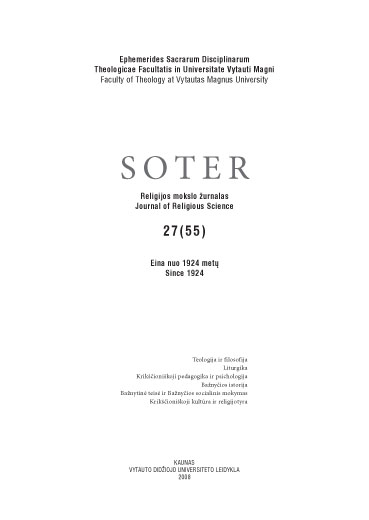Švč. Mergelės Marijos kontempliatyvumas ir šiandienės Bažnyčios savimonė ekumeniniu Požiūriu
CONTEMPLATIVENESS OF THE BLESSED VIRGIN MARY AND THE CONSCIOUSNESS OF TODAY’S CHURCH FROM THE ECUMENICAL POINT OF VIEW
Author(s): Romualdas DulskisSubject(s): Christian Theology and Religion
Published by: Vytauto Didžiojo Universitetas
Keywords: kontempliatyvumas; Švč. Mergelė Marija; Bažnyčia; ekumeninis dialogas; contemplativeness; Blessed Virgin Mary; Church; ecumenical dialogue.
Summary/Abstract: The contemplative life of the Blessed virgin Mary is not only the object of pious admiration, but also an ex¬ample for us to imitate. Mary is often elevated to such a degree that her daily life is not properly noticed. This article will analyze the dimensions of Mary’s contemplativeness and the meaning of contemplativeness in today’s Christian life. Christian vocation in the Catholic Church is traditionally divided into contemplative and active. Supposedly, there exist two paths in Christian spirituality: some decide to serve god in the world; and others (often we have in mind here hermit monks and nuns) retreat from the world. In the Eastern Christian tradition contemplativeness was always conceived as a necessary component of everyone’s Christian vocation. To accomplish this component – one must not choose only one of the two Christian ways, but should decide on the more authentic and radical quality of Christian life. Origen and his followers Evagrius Ponticus and Maximus the Confessor who characterized the three levels of Christian life as follows: 1) the practice of virtue, 2) contemplation of nature, and 3) the contemplation of god. The first level is still often called the active life, which starts with a conscious Christian life. At this stage, one tries to sincerely keep the decalogue, by intensifying one’s sensitivity for right and wrong. Learning to live according to god’s Will, the individual reaches a purity of the heart. Te second and third levels are known as the contemplative life. At the second level the Christian seeks to internalize and comprehend more deeply the basis and purpose of creation’s existence and to perceive the god-likeness of all creation. All life’s spheres are now transfused in faith and religious feeling. At the third level, God is no longer perceived through the conscience or through creation, but directly. A person contemplates God who is above and beyond creation, i.e. an immediate and mature love relationship that is similar to the future face-to-face sight in heaven. However, the latter is more intensive. Mary’s life up to the angel’s Annunciation could appear to us to have been a peaceful, pious and idyllic phase in her life. However, such a one-sided simplification could be said to be naïve. When we reflect on Mary’s youth, it is necessary to perceive her determination, her magnanimity and her maturing within the context of worldly attitudes around her. Without these attributes at the time of the Annunciation, she would not have been strong enough to pronounce her “fat”. The Protestant theologian, Søren Kierkegaard compares Mary’s and Abraham’s faith. Kierkegaard remarks that Mary’s faith surpassed that of Abraham. gospel texts, even though brief, distinctly relate Mary’s contemplativeness, by referring to her as a person submerged in god’s mysteries. She kept her secret to herself, even from Joseph, her betrothed. Mary kept events marked by extraordinary god’s grace in her heart (Luke 2. 29; 51). Kie
Journal: SOTER: religijos mokslo žurnalas
- Issue Year: 55/2008
- Issue No: 27
- Page Range: 43-51
- Page Count: 9
- Language: Lithuanian

